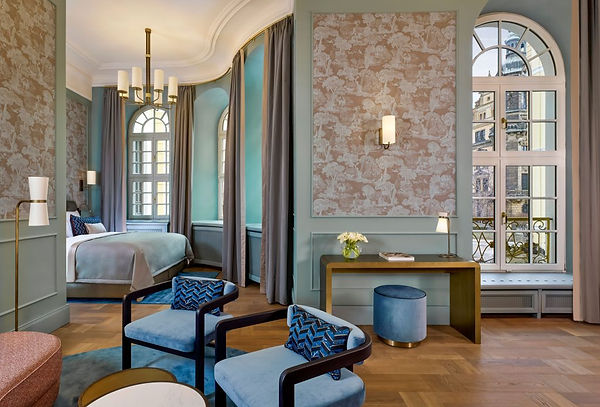
East German cities are not necessarily rich in architecturally remarkable hotels with historical flair. This made the reopening of the Taschenbergpalais Kempinski Dresden, which was originally built as a baroque ensemble by the flamboyant Friedrich August I for Madame de Pompardour, the Countess of Cosel, between the palace and the Zwinger and lay in ruins at the end of the Second World War, all the more exciting.

Baroque beauty as an AI work of art: Madame de Pompadour shapes the sensual spirit of the hotel
From 1992 to 1995, the palace was rebuilt according to old models and using some of the outer walls, but in a modified form compared to its pre-war state. Instead of the destroyed hipped roof, the building was given a mansard roof. Following the reconstruction, which cost a total of 127.8 million euros, the Taschenbergpalais Kempinski Dresden, the first 5-star luxury hotel in Saxony, was opened in March 1995.

Spacious junior suite with a view of historic Dresden.
Now, after another thorough renovation, the baroque-style building exudes fresh royal charm.

The so-called "Grand Palais Room" exudes noble elegance with its gold-colored accents.
For the design, the busy Berlin designer and art collector Markus Hilzinger was inspired by various Dresden landmarks. His credo: a spatial experience that does justice to the legacy of Augustus the Strong and his descendants as well as to Saxon history, while the property managed by General Director Marten Schwass should also meet the requirements of a modern, international luxury hotel.

Happy landlord: Managing Director Marten Schwass in the lobby.
The light-flooded lobby has the potential to become a magnet for travelers as well as local guests thanks to its atmosphere characterized by unusual textile wallpaper, sandstone floors and two cosy lounge areas.

Unconventional color accents liven up the lounge area.
The space, conceived as Dresden's future "living room", will be connected to the newly established patisserie "Amalie" by a special lighting concept based on the course of the Elbe.

A dream in pink: the "Amelie" patisserie impresses with its special cake creations.
The newly designed, freshly furnished 180 rooms and 31 suites also impress with their elegant design, parquet floors, impressive ceiling heights and contemporary luxury.

Modern elegance and skillful color accents: Double washbasin in one of the bathrooms.
Craftsmanship is evident in the use of high-quality materials and the integration of custom-made furniture and fabrics. Variety is created by three different color schemes. Each of these is essentially determined by a historical main color - blue, sage green and sandstone beige.

The living room in the comfortably furnished deluxe suite.
Each of the three designs is characterized by its own wall design, which significantly influences the mood of the room - be it structuring, invigorating, artistic or geometrically arranged. Sustainable and allergy-friendly building materials played a central role in the extensive renovation.

A little playfulness is allowed: Junior suite with ornate wallpaper.
Gastronomically, the Taschenbergpalais aims to impress with several outlets. The main restaurant "Das Palais" offers solid fare with local specialties and international classics. The newly created "Private Dining Room" is recommended for individual occasions.

Creative and cheerful: patissier Yogesh Dutt.
In the "Kastenmeiers" restaurant, chef Gerd Kastenmeier, who is already well known in Dresden, provides guests with sophisticated fish dishes. A special feature here are the fresh and salt water aquariums above the open kitchen, filled with trout, char and lobster, for example. The maritime offer is complemented by a sushi and oyster bar.
Text: Thomas Garms / Photos: Kempinski AG
